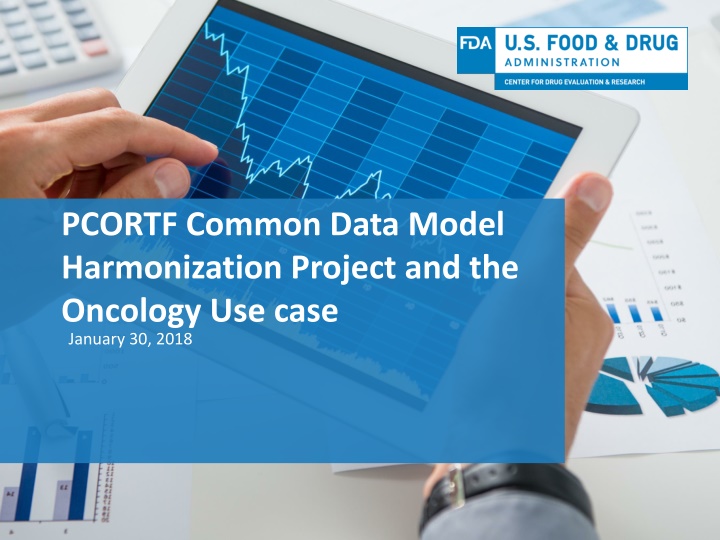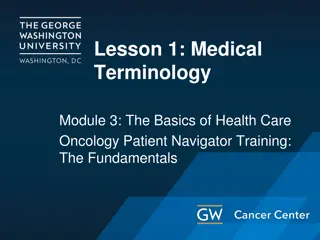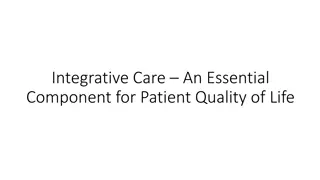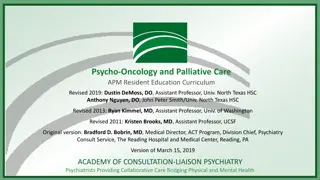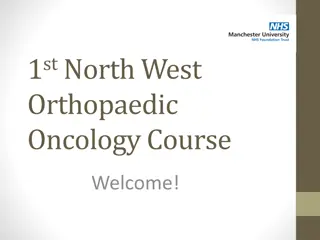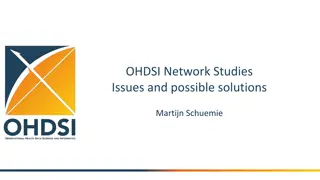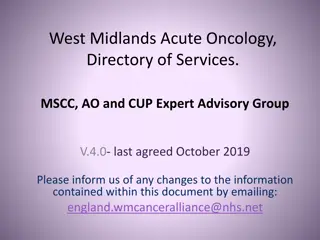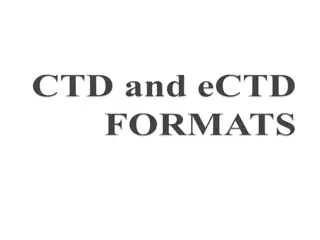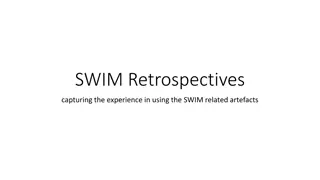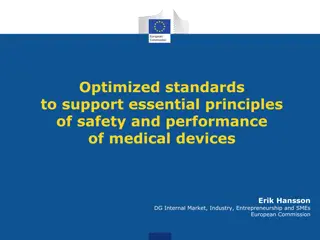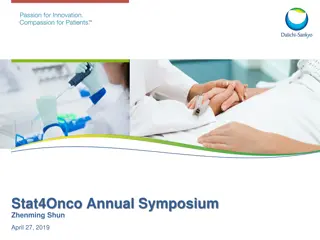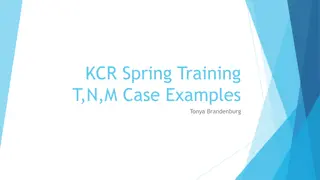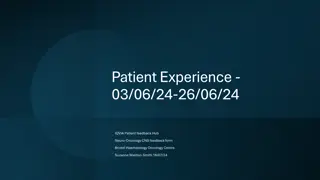PCORTF Common Data Model Harmonization Project and the Oncology Use case
Real world data (RWD) includes various sources like electronic health records, claims data, and patient-generated data which inform on health status. Real world evidence (RWE) is the clinical evidence derived from RWD analysis regarding the usage and benefits/risks of medical products. Goals of RWE include incorporating real-world data into regulatory decisions, improving population diversity, and enhancing efficiencies in healthcare. The use of RWD in clinical trials helps identify participants, sites, and potential off-label uses for drugs. However, the current state of RWD systems faces challenges in connecting data to research platforms, hindering large-scale evidence research.
Download Presentation

Please find below an Image/Link to download the presentation.
The content on the website is provided AS IS for your information and personal use only. It may not be sold, licensed, or shared on other websites without obtaining consent from the author.If you encounter any issues during the download, it is possible that the publisher has removed the file from their server.
You are allowed to download the files provided on this website for personal or commercial use, subject to the condition that they are used lawfully. All files are the property of their respective owners.
The content on the website is provided AS IS for your information and personal use only. It may not be sold, licensed, or shared on other websites without obtaining consent from the author.
E N D
Presentation Transcript
PCORTF Common Data Model Harmonization Project and the Oncology Use case January 30, 2018 1
Real World Data: Definition RWD include data derived from electronic health records (EHRs), claims and billing data, data from product and disease registries, patient-generated data including in home-use settings, and data gathered from other sources that can inform on health status, such as mobile devices. Claims Data Electronic Health Records Laboratory Results Real World Data Registries Vital Records Mobile Devices 2
Real World Evidence: Definition RWE is the clinical evidence regarding the usage and potential benefits or risks of a medical product derived from analysis of RWD. 3
RWE: What are the Goals? Maximize the opportunities to have regulatory decisions incorporate data/evidence from settings that more closely reflect clinical practice Increase the diversity of populations Improve efficiencies Population identification/selection Reduce duplicative capture of data 4 4
RWE: What are the Expectations? 21St Century Cures FDA shall establish a program to evaluate the potential use of real world evidence (RWE) to support: approval of new indication for a drug approved under section 505(c) satisfy post-approval study requirements 5
Real World Data Uses for Clinical Trials Rapidly find large numbers of possible participants with all requirements for clinical trial study: Health history Treatment history Medicine history Range of demographics Range of geographies and rural/urban Rapidly identify sites/clinical investigators Savings of time and money for manufacturers, clinical investigators, and other stakeholders Potential to identify additional off-label uses for approved drugs 6
Current State for Real World Data Thousands of real-world data systems (EHRs, administrative claims data, etc.) Limited data connection to FDA research systems Can not effectively conduct large scale real world evidence research 7
Ideal State for Real World Data Real-time access to real world data systems accessible to FDA researchers: Secure Privacy protected / de-identified sources retain ownership and control of raw data Crosses demographics, geography, etc. Mechanisms to get rapid answers to research questions from pools of millions of patients Without risk of any privacy breach Results are de-identified 8
Current State: Limited groups of connected Real World Data systems Different networks use various sources of healthcare and research data. Creation of different mini-networks for research Allows researcher to query (ask question) and simultaneously, receive results from many different sources. Sentinel Q A BUT: Each network communicates with different agreed upon methods: Common Data Model 19 Data Partners* 9
The current problem with CDMs using International Travel Adapters Different countries use different outlets . There is a need for travel adapters. The Solution: Use a converter between various adapters. Allow researchers to ask a question once and receive results from many different sources using a common agreed-upon standard structure, or a Common Data Model. 10
The solution, using the Adapter Analogy Different countries use different outlets . There is a need for travel adapters. The Solution: Use a converter between various adapters. Allow researchers to ask a question once and receive results from many different sources using a common agreed-upon standard structure, or a Common Data Model. Sentinel I2b2/ACT PCORNET OMOP 11
What do we want to do? PCORTF CDM Harmonization Project Goal: Build a data infrastructure for conducting research using Real World Data derived from the delivery of health care in routine clinical settings. Objective: Develop the method to harmonize the Common Data Models of various networks, allowing researchers to simply ask research questions on much larger amounts of Real World Data than currently possible, leveraging open standards and controlled terminologies to advance Patient-Centered Outcomes Research. 12
Key Players 13
Problems to Solve Networks of observational data use different CDMs. Open, consensus-based standards might not be leveraged in these CDMs (ex: CDISC, HL7) There is a need to facilitate interoperability among these collaborations 14
Additional Goals of CDM Harmonization Project 1. Develop a general framework (i.e., tools, processes, policies, governance and standards) for the transformation of various CDMs, curation, maintenance and sustainability. 2. Assess the value of the developed CDM harmonization mechanisms by demonstrating research utility for safety evaluation of cancer drugs that use the body s immune system (PD1/PDL1 inhibitors) with a focus on patients with autoimmune disorders. 3. Reuse infrastructure developed by currently-funded OS PCORTF projects (NLM Common Data Elements (CDE) Repository, .) 15
Additional Goals of CDM Harmonization Project 4. Leverage open standards and controlled terminologies to advance Patient-Centered Oriented Research. 5. Test methods and tools developed by the collaborative on the universal CDM mapping and transformation approach. 16
Benefits to Public Health and Research Evaluates potential safety concerns Supports provisions of 21st Century Cures Act Supports the Patient Centered Outcomes Research goals Enhances regulatory decisions by providing reviewers with access to a larger network of RWD data Supports the goals outlined in the All of us (Precision Medicine Initiative) 17
Mapping Validation Process Steps Mapped the Common Data Models (CDMs) to BRIDG 5.0.1 Sentinel - DONE Patient-Centered Outcomes Research Network (PCORNET) DONE Observational Medical Outcomes Partnership (OMOP) DONE Informatics for Integrating Biology & the Bedside (i2B2) / Accrual for Clinical Trials (ACT) Planned 19
Mapping Spreadsheet Mapping Path Examples 20
Process Of Building The CDMH BRIDG View Start with the BRIDG Enterprise Architect Project (EAP) file (BRIDG 5.0.1) Create a new diagram and pull the relevant BRIDG classes and associations into the new BRIDG view (CDMH View) Based on the BRIDG classes in the mapping spreadsheets of the four (Sentinel, PCORNET, i2B2, OMOP) models. For each class, display only the attributes that have a mapping in the network models Bring in supporting BRIDG structures, as needed Add new classes and attributes to represent the semantics missing in BRIDG as DRAFT extensions Represented as subtype classes with attributes 22
DRAFT CDMH BRIDG View Clinical Trial related DRAFT / WORK-IN-PROGRESS CDMH Conceptual BRIDG View Does Not Include OMOP -Still Being Reviewed 23
Next Steps Complete i2b2/ACT mapping Complete consolidated 4-model mapping spreadsheet To ensure consistency in mapping Update the CDMH Conceptual Model BRIDG harmonization may result in modifications Subset of BRIDG model that only shows the classes and attributes that are in scope of CDMH project AND the new classes/attributes that were added to BRIDG as a result of this project Create CDMH logical model Develop plan to capture the design decisions Create CDMH physical model Create the CDMH physical model to the 4 networks models 24
Additional deliverables Mapping showing the BRIDG-based CDMH physical model tables/columns to FHIR STU 3 resources/elements Mapping showing the BRIDG-based CDMH physical model tables/columns to CDISC SDTM domain and variables It is likely that not all the attributes in CDMH model will have SDTM mappings Consider providing feedback to CDISC for the gaps 25
Thank You 26
